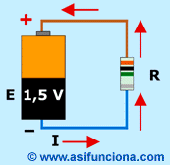Ley de Ohm
LA LEY DE OHM
La Ley de Ohm, postulada por el físico y matemático alemán
Georg Simon Ohm, es una de las leyes fundamentales de la electrodinámica,
estrechamente vinculada a los valores de las unidades básicas presentes en
cualquier circuito eléctrico como son:
Tensión o voltaje "E", en volt (V).
Intensidad de la corriente " I ", en ampere (A).
Resistencia "R" en ohm () de la carga o consumidor
conectado al circuito.
Circuito eléctrico cerrado compuesto por una pila de 1,5
volt, una resistencia o carga eléctrica "R" y la. circulación de una
intensidad o flujo de corriente
eléctrica " I " suministrado por la propia pila.
Debido a la existencia de materiales que dificultan más que
otros el paso de la corriente eléctrica a través de los mismos, cuando el valor
de su resistencia varía, el valor de la intensidad de corriente en ampere
también varía de forma inversamente proporcional. Es decir, a medida que la
resistencia aumenta la corriente disminuye y, viceversa, cuando la resistencia
al paso de la corriente disminuye la corriente aumenta, siempre que para ambos
casos el valor de la tensión o voltaje se mantenga constante.
Por otro lado y de acuerdo con la propia Ley, el valor de la
tensión o voltaje es directamente proporcional a la intensidad de la corriente;
por tanto, si el voltaje aumenta o disminuye, el amperaje de la corriente que
circula por el circuito aumentará o disminuirá en la misma proporción, siempre
y cuando el valor de la resistencia conectada al circuito se mantenga
constante.
OHM LAW
The law of
Ohm, postulated by the German physicist and mathematician Georg Simon Ohm, is
one of the fundamental laws of electrodynamics, closely linked to the values
of the basic units present in any electric circuit such as:
Voltage or
voltage "E", in volt (V).
Intensity
of current "I", in ampere (A).
Resistance
"R" in ohm () of the load or consumer connected to the circuit.
Closed
electric circuit consisting of a 1.5 volt battery, an electrical resistance or
load "R" and the. Circulation of an electric current or current
"I" supplied by the battery itself.
Due to the
existence of materials that impede more than others the passage of the electric
current through them, when the value of their resistance varies, the value of
the ampere current also varies inversely proportional. That is to say, as the
resistance increases the current decreases and vice versa, when the resistance
to the passage of the current decreases the current increases, provided that
for both cases the value of the voltage or voltage is kept constant.
On the
other hand and according to the Law itself, the value of the voltage or voltage
is directly proportional to the current intensity; Therefore, if the voltage
increases or decreases, the amperage of the current flowing through the circuit
will increase or decrease in the same proportion, as long as the value of the
resistance connected to the circuit remains constant.




Comentarios
Publicar un comentario